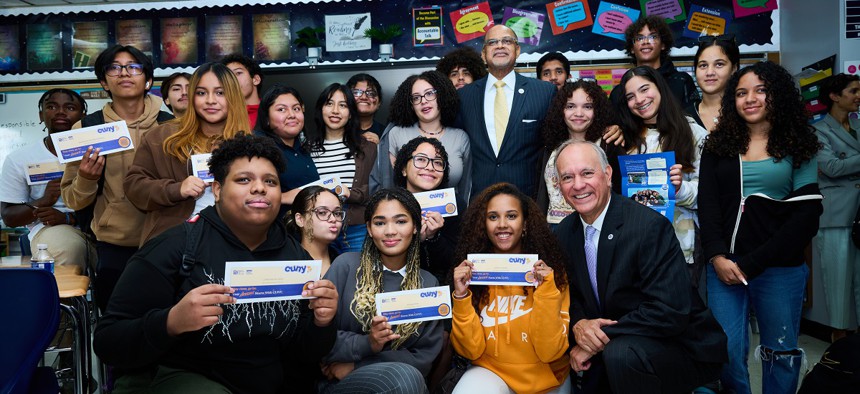Education
‘Turned a corner’ on enrollment: CUNY chancellor on system’s post pandemic recovery
This October, the nation's largest urban public university is ramping up its efforts to recruit New York City high school seniors by waiving application fees and deploying welcome letters.

CUNY Chancellor Félix V. Matos Rodríguez and NYC Schools Chancellor David C. Banks give welcome letters to seniors at City College Academy of the Arts. CUNY / Marcus Beasley
With October underway, the City University of New York system is fanning out across the city to host over 100 informational events, deploying welcome letters and waiving application fees, in an effort to recruit more New York City high school seniors.
The efforts, coined CUNY Month, come as the sprawling system continues to grapple with and rethink what it means to be a New York City public university in a post pandemic world. During his annual State of the University Address Tuesday morning, CUNY Chancellor Félix V. Matos Rodríguez said the system has come a long way since the onset of the COVID-19 pandemic ravaged universities and colleges across the country, spurring enrollment decline and financial challenges.
For the first time in three years, Matos Rodríguez said, enrollment is on the upswing. According to the chancellor, preliminary data shows that the number of freshmen enrolled at CUNY institutions is up more than 4% while the number of transfer students has grown nearly 7%. CUNY and other city leaders hope to build on this momentum going forward, which is in part where the plans to spur recruitment by reaching out to high schoolers throughout October comes in.
Through a broader partnership with the New York City Department of Education to create a more seamless transition into higher education, CUNY has begun sending personalized welcome letters to all public high school seniors who are on track to graduate in 2024 – approximately 65,000 – encouraging them to enroll in college. That’s just one aspect of CUNY’s ambitious plan to transform the system over the next 7 years. The system is also streamlining student transfers and working to improve career options by building relationships with employers and increasing the number of students who complete paid internships.
“This is the time of the year when seniors are applying to colleges and we need to say loud and clear, there is a place for each one of you at CUNY,” Matos Rodríguez said.

